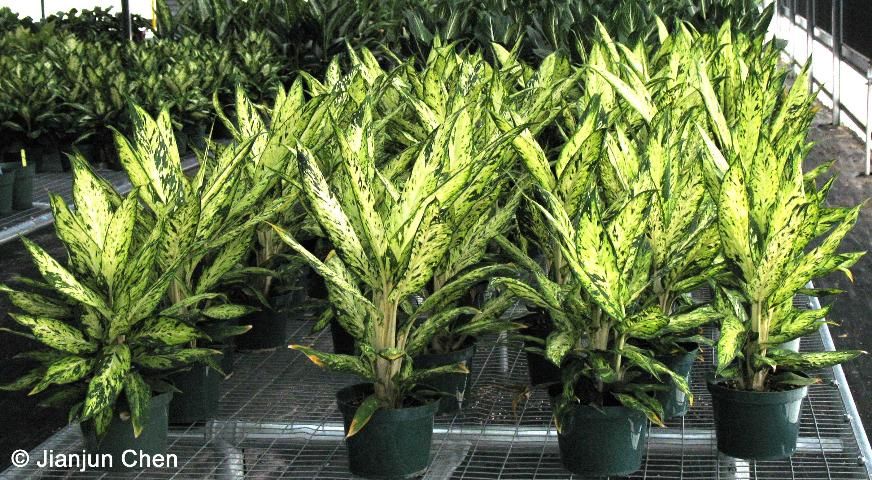Cultural Guidelines for Commercial Production of Interiorscape Dieffenbachia
Dieffenbachia is a monocot of the Araceae family native to the Caribbean, Central America, and South America with about 30 species and over 100 cultivars. It is a popular choice among interiorscapers due to its low light tolerance, easy production, and attractive foliar variegation. Some of its common names include Dumb Cane, Leopard Lily, Galatea, Mother-in-law Plant, and Yalu Ni Vavalagi. This article describes common species and cultivars in the foliage plant industry (see Table 1), provides guidelines for their culture and interior use, and lists physiological problems that may be encountered during production and interiorscape use (see Table 3).
Although popular for their ornamental values, Dieffenbachia plants should be handled with great caution because all parts of the plant contain calcium oxalate crystals, proteolytic enzymes, and certain compounds that can cause inflammation on contact. Ingestion of Dieffenbachia causes irritation of the lips, mouth, throat, and tongue, hence the common name dumb Cane. Contact with the plant sap can also irritate the skin. Thus, wearing gloves and other protective covering is suggested when handling this plant. Additionally, it is best to prevent children and pets from physical contact with Dieffenbachia.

Credit: UF/IFAS
Cultural Guidelines
Propagation
Dieffenbachia can be propagated by seed, tip or cane cuttings, division, and tissue culture. Seed is not commonly used except in breeding. Rooting is performed in media containing 50% peat, 25% bark, and 25% perlite by volume with pH 5 to 6 and soluble salts readings of 1 to 2 dS/m. Roots will form in 3 to 8 weeks if a minimum media temperature of 75° F and proper media moisture are maintained. Most Dieffenbachia species are now propagated by tissue culture because viruses and pathogens can be eliminated through this method.
Production
Rooted cuttings or tissue cultured liners can be planted in 6-inch, 8-inch, or 10-inch pots, depending on cultivar, using commercial media that are formulated with peat, pine bark, vermiculate, or perlite. Media pH should be 6.0 to 6.5 and soluble salts levels of 1 to 2 dS/m. Plants should be grown in greenhouses under 80% shade (2,500 foot candles), relative humidity of 60 to 100%, and temperatures between 60 and 90° F. If plants are fertigated via a drip or ebb-and-flow irrigation, water-soluble fertilizers with N-P2O5-K2O at 3-1-2 ratio, such as a 24-8-16 or 18-6-12 with micronutrients, can be dissolved in irrigation water to obtain a solution with N at a concentration of 200 ppm. Depending on production temperatures, plants can be fertigated once or twice a week using the solution. If controlled-release fertilizers with N-P2O5-K2O ratios of 3-1-2 are used, apply 24 lb N per 1,000 square feet annually. Potting media should be kept moist but not wet when controlled-release fertilizers are used in production. Growers are strongly recommended to monitor the nutrient status of potting media by checking soluble salts levels biweekly using an electrical conductivity (EC) meter. Media solution can easily be extracted by the pour-through method. If EC readings fall below 1.0 dS/m, additional fertilization is needed; whereas if EC readings are above 3.0 dS/m, growers should reduce either the frequency or amount of fertilizer applications. It is also recommended to stop fertilizing one month before shipment. Table 2 provides a general guide for determining if Dieffenbachia is appropriately fertilized based on leaf analysis.
Shipping and Interior Care
During shipping, maintain a temperature range of 60 to 65°F. If the temperature drops below 55°F, chilling injury may occur. Dieffenbachia leaves are fragile, so a sleeve is needed. Handle the plants with gloves to prevent irritation from the sap.
Dieffenbachia species have been used in interiorscapes for over 100 years, but maintaining its aesthetic appearance indoors is a challenge. Plants may lose foliar variegation and become tall and leggy. Also, leaf edges may dry and turn brown or the lower leaves may die. The secrets to interior success are as follows. (1) Select the right cultivars for the interior light levels. For example, 'Star Bright' and 'Snow Flake' will tolerate low light levels of 50 foot candles, whereas 'Camille' requires of 150-250 foot candles to remain attractive. Inappropriate low light levels cause foliar variegation reduction and excess stem elongation. (2) Reduce or cease fertilizing. If soluble salts are 1.0 dS/m or above when solution is extracted by the pour-through method, do not fertilize; if soluble salt levels are higher than 2.0 dS/m, leach the media with water to reduce potential leaf burning. Usually, plants do not need fertilizer for at least two months after purchase. Afterward, water with a solution containing N at 100 ppm made from a water-soluble fertilizer mentioned above once a month. (3) Maintain a temperature range of 70 to 85°F and avoid drafts. (4) Do not expose plants to direct sun or excessive brightness, which may give leaves a washed-out appearance. (5) Keep media moist but not wet.
Remove lower leaves as they eventually drop. If the foliage becomes too sparse, trimming it back to a 6-inch height can revitalize it. Wipe the leaves from time to time with a damp cloth to remove dust. Repot the plant as needed.


